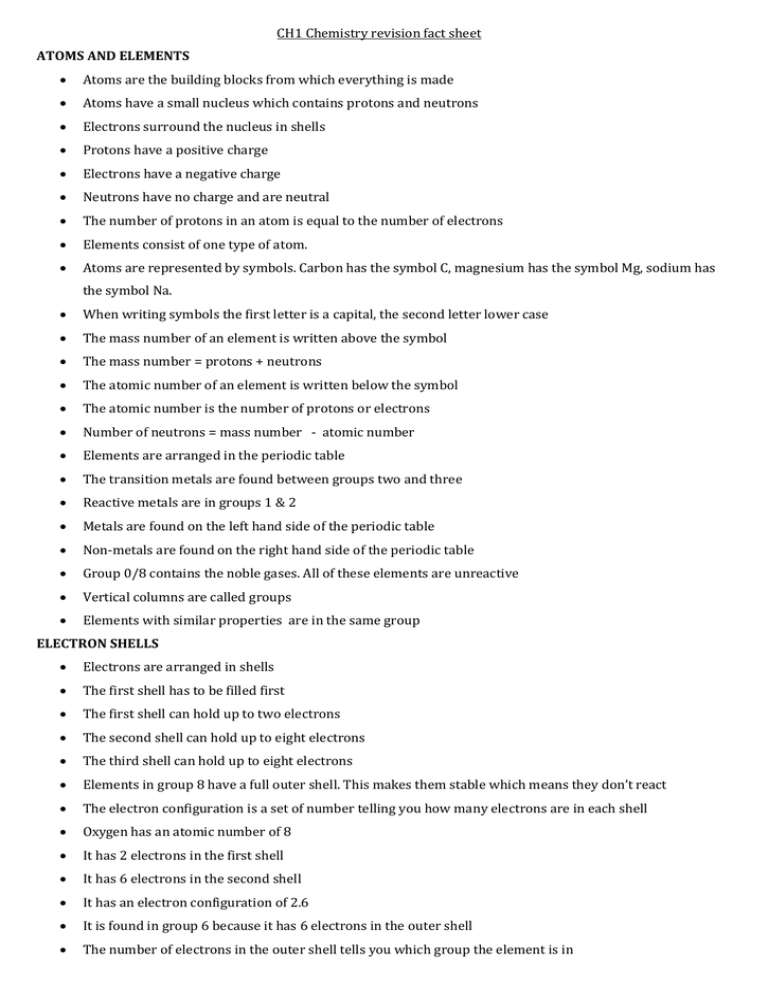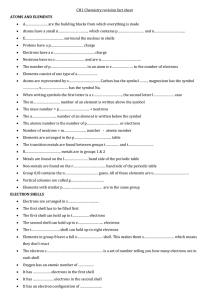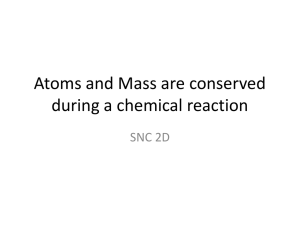CH1 Fact sheet
advertisement

CH1 Chemistry revision fact sheet ATOMS AND ELEMENTS Atoms are the building blocks from which everything is made Atoms have a small nucleus which contains protons and neutrons Electrons surround the nucleus in shells Protons have a positive charge Electrons have a negative charge Neutrons have no charge and are neutral The number of protons in an atom is equal to the number of electrons Elements consist of one type of atom. Atoms are represented by symbols. Carbon has the symbol C, magnesium has the symbol Mg, sodium has the symbol Na. When writing symbols the first letter is a capital, the second letter lower case The mass number of an element is written above the symbol The mass number = protons + neutrons The atomic number of an element is written below the symbol The atomic number is the number of protons or electrons Number of neutrons = mass number - atomic number Elements are arranged in the periodic table The transition metals are found between groups two and three Reactive metals are in groups 1 & 2 Metals are found on the left hand side of the periodic table Non-metals are found on the right hand side of the periodic table Group 0/8 contains the noble gases. All of these elements are unreactive Vertical columns are called groups Elements with similar properties are in the same group ELECTRON SHELLS Electrons are arranged in shells The first shell has to be filled first The first shell can hold up to two electrons The second shell can hold up to eight electrons The third shell can hold up to eight electrons Elements in group 8 have a full outer shell. This makes them stable which means they don’t react The electron configuration is a set of number telling you how many electrons are in each shell Oxygen has an atomic number of 8 It has 2 electrons in the first shell It has 6 electrons in the second shell It has an electron configuration of 2.6 It is found in group 6 because it has 6 electrons in the outer shell The number of electrons in the outer shell tells you which group the element is in COMPOUNDS AND CHEMICAL REACTIONS Two or more elements chemically joined together are called a compound Atoms react to form full outer shells and become stable There are two types of bonding Covalent bonding occurs between 2 non metals The electrons are shared An example of a covalent compound is hydrogen chloride Ionic bonding occurs between a metal and a non metal The metal loses electrons and becomes a positive ion The non-metal gains electrons and becomes a negative ion An example of ionic bonding is sodium chloride The positive and negative ions attract each other and stick together Chemical equations show reactants products The number of atoms at the start of a reaction = the number of atoms at the end of a reaction magnesium + oxygen magnesium oxide 2Mg + O2 2MgO LIMESTONE The formula of limestone is CaCO3 and the chemical name is calcium carbonate Limestone undergoes thermal decomposition when heated The products are calcium oxide and carbon dioxide Calcium oxide is also known as quicklime and the chemical formula is CaO Carbon dioxide is tested for using limewater which goes cloudy Calcium oxide reacts with water to make calcium hydroxide This is also known as slaked lime and has the chemical formula Ca(OH)2 Slaked lime is an alkali and is used to neutralise acidic soil Limestone is heated with clay to make cement Cement is mixed with sand and water to make mortar. This is used for sticking bricks together Concrete is made by mixing cement, sand and aggregate together Gravel and water are together known as aggregate Limestone is obtained by quarrying Advantages of quarrying Supplies materials Products for buildings and roads Products for neutralisation – of acidic lakes and soil Provides jobs Disadvantages of quarrying Ugly Noisy Produces dust Waste Destroys habitats Pollution METALS Ores are rocks that contain metals that can be extracted Method of extraction depends on place in the reactivity series Potassium Sodium Calcium Magnesium Aluminium Carbon Zinc Iron Tin Copper Those metals above carbon are extracted by electrolysis Those metals below carbon are extracted by reduction Three native metals are silver, gold and platinum. This means they are found naturally Reduction is the removal of oxygen The ore is reacted with carbon to produce carbon dioxide Iron oxide + carbon iron + carbon dioxide Electrolysis means splitting by electricity You need a liquid to conduct electricity But this means high temperatures and lots of electricity is needed which makes the process expensive Copper can be purified by electrolysis It needs to purified for use in electrical wiring The negative electrode is made of pure copper The positive electrode is made of impure copper The liquid used is copper sulphate solution Positive copper ions are attracted to the negative electrode, which gets bigger IMPACTS OF EXTRACTING METALS Metals can be extracted by displacement This means a more reactive metal will remove a less reactive metal from a compound Copper sulphate + iron iron sulphate + copper There are two new extraction methods for copper Bioleaching - bacteria separate copper from copper sulphide A leachate is produced which can be filtered to extract copper Phytomining – plants are grown in soil containing copper The copper is absorbed and stored in the leaves The leaves are then burnt and copper is collected from the ash Extracting metals is bad for the environment It creates Noise Dust Damages landscapes and habitats Dangerous when mines are abandoned Reasons for recycling Mining is expensive and needs a lot of energy from fossil fuels Fossil fuels have to be burnt – which causes pollution so this reduces Fossil fuels are running out Recycling uses less energy Recycling cuts down on landfill sites PROPERTIES OF METALS Metals are strong and bendy Also good conductors of heat and electricity Found on left hand side of periodic table and in the central block (transition metals) Copper has properties that make it useful for wiring and plumbing Good conductor of heat and electricity Can be bent but is still hard Doesn’t react with water Aluminium is low density (light) and resistant to corrosion (doesn’t break down) making it good to use to make aeroplanes Titanium is low density and corrosion resistant making it good to use for hip replacements ALLOYS An alloy is a mixture of metals Alloys are harder than pure metals Iron from the blast furnace contains 96% iron and it is very brittle - useless Most iron is converted into steel by mixing with carbon Low carbon steels are easily shaped – useful for car bodies High carbon steels are hard – useful for bridges Stainless steels are resistant to corrosion – useful for cutlery Most everyday metals are alloys Pure gold, copper and aluminium are too soft and mixed with small amounts of similar metals to make them harder. CRUDE OIL Crude oil is a mixture of hydrocarbons, which only contain hydrogen and carbon Crude oil can be split into separate groups of hydrocarbons by fractional distillation. Different hydrocarbons separate at different temperatures and are collected as they condense. Crude oil is made up of hydrocarbons called alkanes. Alkanes are made up of carbon atoms surrounded by hydrogen. Each carbon atoms has 4 other atoms bonded to it. The general formula for alkanes is CnH2n+2. This means that there are twice as many hydrogen atoms plus two extra compared to carbons. The first three alkanes are methane (CH4), ethane (C2H6) and propane (C3H8) The shorter the hydrocarbon chain the less viscous (gloopy) the alkane the lower the boiling point the more flammable Crude oil is an important fuel, but it will eventually run out as it is non-renewable. Burning crude oil releases Carbon dioxide Water Carbon monoxide Sulphur dioxide Nitrogen oxide The burning of fuels releases energy The carbon and hydrogen atoms are oxidised (oxygen is added) Sulphur dioxide and nitrogen oxide cause acid rain which causes lakes to become acidic and damages building Carbon dioxide causes global warming Solid particles cause global dimming Sulphur can be removed from the fuels before they are burned Sulphur dioxide can be removed from waste gases after combustion in power stations Alternative fuels are being developed such as ethanol, hydrogen gas and biodiesel from plant material These reduce the amount of pollution produced Long chain hydrocarbons can be cracked (split up) into more useful products Cracking is a thermal decomposition reaction – molecules are broken down by heating them The chain is heated to vaporise it, then the vapour is passed over a catalyst. The long chain is split apart. Most of the products of cracking are alkanes and alkenes Alkenes have a carbon – carbon double bond. They are unsaturated The general formula is CnH2n. There are twice as many hydrogen atoms as carbon atoms The first 2 alkenes are ethene (C2H4) and propene (C3H6) Alkenes contain a double C=C bond – they are unsaturated Unsaturated alkenes react with orange bromine water and turn it colourless POLYMERS Alkenes can be used to make polymers Polymerisation is the process by which lots of small alkenes (monomers) are joined together to make large long chain molecules called polymers Lots of ethene molecules can be joined together to make poly(ethene) Different polymers have different physical properties that are affected by temperature and pressure Polythene is used to make plastic bags Polymers are cheap but don’t biodegrade. It is difficult to get rid of them Plastic bags are being made from polymers and cornstarch so they break down more easily Ethene can be reacted with steam to produce ethanol. A catalyst is used to speed up the reaction Ethanol can also be produced by fermentation with yeast. Sugar carbon dioxide and ethanol PLANT OILS We can extract oils from plants. These oils can be used for food or fuel The plant material is crushed and pressed to remove the oil. Distillation refines the oil and removes water, solvents and impurities Vegetable oils are used in food and provide a lot of energy Vegetable oils have higher boiling points than water so can be used to cook at higher temperatures This produces quicker cooking and different flavours, but increases the energy released when eaten Emulsions can be made from oil and water. Emulsions are made from lots of droplets of one liquid suspended in another liquid The more oil you have the thicker the emulsion Emulsions provide better texture, coating ability and appearance Salad dressing, ice cream, cosmetics and paints are examples of emulsions Emulsifiers have hydrophilic (water seeking) and hydrophobic (water avoiding)properties. Vegetable oils that are unsaturated contain double carbon= carbon bonds These are detected by bromine water Unsaturated oils can be hydrogenated – hardened by reacting them with hydrogen in the presence of a nickel catalyst at about 60oC. Hydrogenated oils have a higher melting point so they are more solid at room temperature, which makes them more useful as spreads and for cake baking THE EARTH The Earth consists of a crust, mantle, outer and inner core The crust is the very thin outer layer. The mantle has all the properties of a solid but it can flow. Within the mantle radioactive decay takes place producing a lot of heat, which causes the mantle to flow in convection currents. The core of the Earth is made of nickel and iron. The Earth’s surface is made up of tectonic plates, which drift because of convection currents in the mantle. The movement of the plates can be sudden and disastrous Earthquakes are caused by the plates moving very quickly Volcanoes form at the boundaries between 2 tectonic plates Wegener proposed a theory of continental drift to explain how the plates moved Originally the land was joined in a big mass called Pangaea The convection currents formed in the mantle caused the plates to slowly move apart Initially people didn’t believe his theory and thought mountains were formed from the shrinking of the Earth as it cooled Wegener proved his theory by Matching shape of continents – South America and Africa Matching rock samples – found on different continents Similar fossils found on different continents THE EARTH’S ATMOSPHERE The atmosphere has evolved and changed over time Currently the atmosphere is roughly 78% nitrogen, 21% oxygen and 1% other gases During the first billion years on Earth there was intense volcanic activity This released gases that formed the early atmosphere and water vapour The water vapour cooled and condensed to form the oceans There are several theories as to how the atmosphere was formed. One suggests that the atmosphere was mainly carbon dioxide and little oxygen. There would have been a little water vapour and some methane and ammonia The green plants evolved and began to produce oxygen by photosynthesis This was the oxygen that is now in the atmosphere. Most of the carbon dioxide in the air became locked up in sedimentary rocks and fossil fuels The oceans also absorb carbon dioxide, but increased amounts of carbon dioxide impact on marine life. Carbon dioxide is now released by the burning of fossil fuels. It is a greenhouse gas and contributes to climate change









